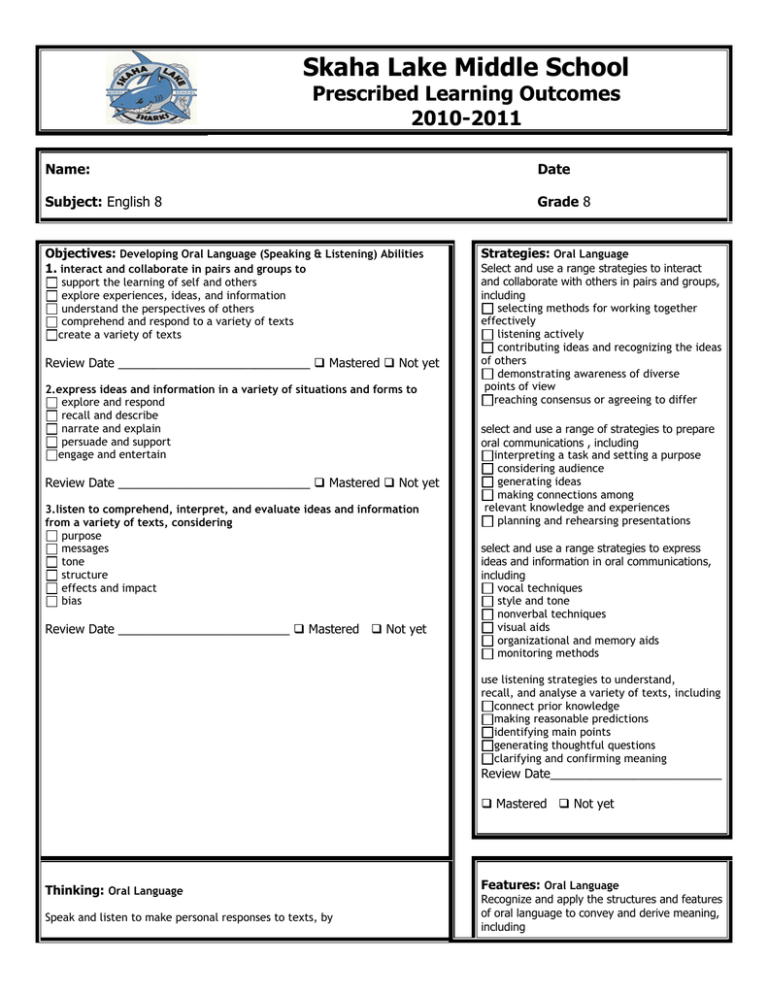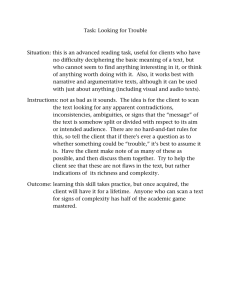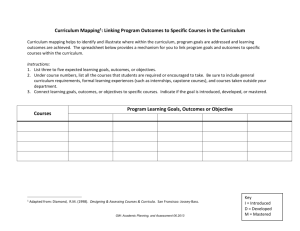Skaha Lake Middle School Prescribed Learning Outcomes 2010-2011
advertisement

Skaha Lake Middle School Prescribed Learning Outcomes 2010-2011 Name: Date Subject: English 8 Grade 8 Objectives: Developing Oral Language (Speaking & Listening) Abilities 1. interact and collaborate in pairs and groups to support the learning of self and others explore experiences, ideas, and information understand the perspectives of others comprehend and respond to a variety of texts create a variety of texts Review Date ____________________________ Mastered Not yet 2.express ideas and information in a variety of situations and forms to explore and respond recall and describe narrate and explain persuade and support engage and entertain Review Date ____________________________ Mastered Not yet 3.listen to comprehend, interpret, and evaluate ideas and information from a variety of texts, considering purpose messages tone structure effects and impact bias Review Date _________________________ Mastered Not yet Strategies: Oral Language Select and use a range strategies to interact and collaborate with others in pairs and groups, including selecting methods for working together effectively listening actively contributing ideas and recognizing the ideas of others demonstrating awareness of diverse points of view reaching consensus or agreeing to differ select and use a range of strategies to prepare oral communications , including interpreting a task and setting a purpose considering audience generating ideas making connections among relevant knowledge and experiences planning and rehearsing presentations select and use a range strategies to express ideas and information in oral communications, including vocal techniques style and tone nonverbal techniques visual aids organizational and memory aids monitoring methods use listening strategies to understand, recall, and analyse a variety of texts, including connect prior knowledge making reasonable predictions identifying main points generating thoughtful questions clarifying and confirming meaning Review Date_________________________ Mastered Not yet Thinking: Oral Language Speak and listen to make personal responses to texts, by Features: Oral Language Recognize and apply the structures and features of oral language to convey and derive meaning, including making connections with prior knowledge and experiences describing reactions and emotions generating thoughtful questions speak and listen to interpret and analyse ideas and information from texts, by examining and comparing ideas and elements within and among texts identifying perspectives indentifying bias and contradictions speak and listen to synthesize and extend thinking, by personalizing ideas and information explaining relationships among ideas and information applying new ideas and information transforming existing ideas and information context text structures syntax diction usage conventions rhetorical devices vocal techniques nonverbal techniques Review Date_________________________ Mastered Not yet use metacognitive strategies to reflect on and assess their speaing and listening, by referring to criteria setting goals for improvement creating a plan for achieving goals evaluating progress and setting new goals Review Date _________________________ Mastered Not yet Comments __________________________________________________________ __________________________________________________________ __________________________________________________________ __________________________________________________________ Final Review Date ___________________________________ Level is: Mastered Not yet Sp. Ed. Teacher’s Signature______________________ Principal’s Signature______________________ Skaha Lake Middle School Prescribed Learning Outcomes 2010-2011 Name: Date Subject: English 8 Grade 8 Objectives: Developing Reading and Viewing Abilities 1. Reading and viewing read, both collaboratively and independently, to comprehend a variety of literary texts, including traditional forms Aboriginal and other cultures significant works of Canadian literature (e.g., the study of plays, short stories, poetry, or novels) literature reflecting a variety of prose forms poetry in a variety of narrative and lyric forms literature reflecting a variety of times, places, and perspectives read, both collaboratively and independently, to comprehend a variety of information and persuasive texts with some complexity, including articles and reports biographies and autobiographies textbooks, magazines, and newspapers print and electronic reference material advertizing and promotional material opinion-based material student generated material advertizing and promotional materials read, both collaboratively and independently, to comprehend a variety of visual texts, such as broadcast media web sites graphic novels film and video photographs art visual components of print media student-generated material independently select and read, for sustained periods of time, texts for enjoyment and to increase fluency Review Date ____________________________ Mastered Not yet Thinking: Reading and Viewing Explain and support personal responses to texts, by making connections with prior knowledge and experiences describing reactions and emotions generating thoughtful questions developing opinions using evidence interpret and analyse ideas and information from texts, by Strategies: Reading and Viewing before reading and viewing, select and use a range of strategies to anticipate content and construct meaning, including interpreting a task making logical predictions generating guiding questions setting a purpose accessing prior knowledge during reading and viewing, select and use a range of strategies to construct, monitor, and confirm meaning, including predicting, questioning, visualizing, and making connections making inferences and drawing conclusions differentiating main ideas and supporting details using text features determining the meaning of unknown words and phrases self-monitoring and self-correcting summarizing after reading and viewing, select and use a range of strategies to confirm and extend meaning, including responding to text asking questions making inferences and drawing conclusions reviewing text and purpose for reading summarizing, synthesizing, and applying ideas Review Date_________________________ Mastered Not yet Features: Reading and Viewing Recognize and explain how structures and features of texts shape readers’ and viewers’’ construction of meaning, including, including form and genre functions of text literary elements literary devices making and supporting judgments examining and comparing ideas and elements within and among texts identifying points of view identifying bias and contradictions synthesize and extend thinking about texts, by personalizing ideas and information explaining relationships among ideas and information applying new ideas and information transforming existing ideas and information use metacognitive strategies to reflect and assess their reading and viewing, by referring to criteria setting goals for improvement creating a plan for achieving goals evaluating progress and setting new goals use of language non-fiction elements visual/artistic devices demonstrate increasing word skills and vocabulary knowledge, by analyzing the origins and roots of words determining meanings and uses of words based on context using vocabulary appropriate to audience and purpose Review Date_________________________ Mastered Not yet Review Date _________________________ Mastered Not yet Comments __________________________________________________________ __________________________________________________________ __________________________________________________________ __________________________________________________________ __________________________________________________________ __________________________________________________________ Final Review Date ___________________________________ Level is: Mastered Not yet Sp. Ed. Teacher’s Signature______________________ Principal’s Signature______________________ Skaha Lake Middle School Prescribed Learning Outcomes 2010-2011 Name: Date Subject: English 8 Grade 8 Objectives: Developing Writing and Representing Abilities write meaningful personal texts that explore ideas and information to experiment express self make connections reflect and respond remember and respond write purposeful information texts that express ideas and information to explore and respond record and describe analyse and explain persuade engage write effective imaginative texts to explore ideas and information to make connections and develop insights explore literary forms and techniques experiment with language and style engage and entertain create thoughtful representations that communicate ideas and information to explore and respond record and describe explain and persuade engage Review Date ____________________________ Mastered Not yet Strategies: Writing and representing Select and use a range of strategies to generate, develop, and organize ideas for writing and representing, including making connections setting a purpose and considering an audience gathering and summarizing ideas from personal interest, knowledge, and inquiry analyzing writing samples or models setting class-generated criteria select and use a range of drafting and composing strategies while writing and representing, including using a variety of sources to collect ideas and information generating text organizing ideas and information analyzing writing samples or models creating and consulting criteria select and use a range of strategies to revise, edit, and publish writing and representing, including checking their work against established criteria enhancing supporting details and examples refining specific aspects and features of text proofreading Review Date_________________________ Mastered Not yet Features: Writing and representing Use and experiment with elements of style in writing and representing, appropriate to purpose and audience, to enhance meaning and artistry, , including syntax and sentence fluency diction point of view literary devices visual/artistic devices Thinking: Writing and representing Write and represent to explain and support personal responses to texts, by making connections with prior knowledge and experiences describing reactions and emotions generating reactions and emotions developing opinions using evidence write and represent to interpret and analyse use and experiment with elements of form in writing and representing, appropriate to purpose and audience, to enhance meaning and artistry, including organization of ideas and information text features and visual/artistic devices ideas and information from texts, by making and supporting judgments examining and comparing ideas and elements within and among texts identifying point of view identifying bias and connections use conventions in writing and representing, appropriate to purpose and audience, to enhance meaning and artistry, including grammar and usage punctuation, capitalization, and Canadian spelling copyright and citation of references presentation/layout write and represent to synthesize and extend thinking, by personalizing ideas and information explaining relationships among ideas and information transforming existing ideas and information Review Date _________________________ Mastered Not yet use metacognitive strategies to reflect on and assess their writing and representing, by relating their work to criteria setting goals for improvement creating a plan for achieving goals evaluating progress and setting new goals Review Date ________________________ Mastered Not yet Comments __________________________________________________________ __________________________________________________________ __________________________________________________________ __________________________________________________________ __________________________________________________________ __________________________________________________________ __________________________________________________________ __________________________________________________________ Final Review Date ___________________________________ Level is: Mastered Not yet Sp. Ed. Teacher’s Signature______________________ Principal’s Signature______________________





